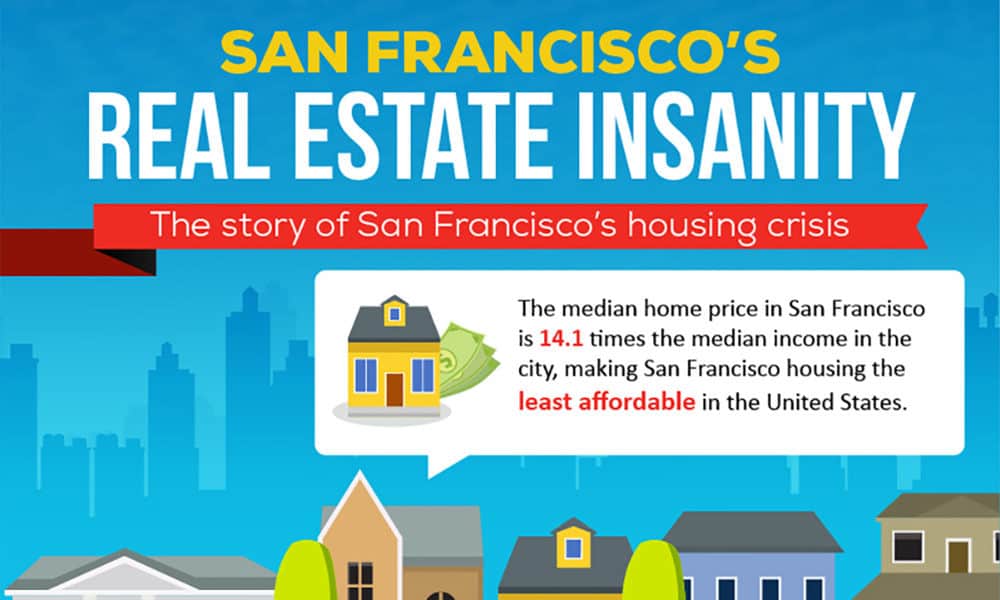


SHARE THIS INFOGRAPHIC ON YOUR SITE WITH THE FOLLOWING CODE:
<p><a href='http://www.investmentzen.com/news/san-franciscos-real-estate-insanity/'><img src='https://investmentzen-569f.kxcdn.com/blog/wp-content/uploads/2017/05/San-Francisco’s-Real-Estate-Insanity.jpg' alt='San Francisco's Real Estate Insanity' width='800px' border='0' /></a></p>
<p>Via: <a href="http://www.investmentzen.com/news/san-franciscos-real-estate-insanity/">InvestmentZen.com</a></p>
How did we get here?
An in-depth look at San Francisco’s complicated housing history:
1848 – Gold Rush! – Gold was discovered in the American River by James W. Marshall on January 24, 1848. Thousands flocked to California from all over to strike it rich.
The population of San Francisco went from 1,000 in 1848 to over 20,000 in 1850.
In order to accommodate the influx, San Francisco started building on a grid system with small roads. This initial city block layout with small roads hasn’t changed much since then.
1906 – Earthquake! – On April 18, 1906, a 7.8 magnitude earthquake shook San Francisco. The quake broke water and gas lines throughout the city and fires that burned for three days devastated what remained. When the dust settled, 80% of the city had been burned and 250,000 people (over half of the city’s population of 400,000) were homeless.
The rebuilding efforts added denser housing while mostly maintaining the original city layout. The percent of flats and apartment units in the city went from 50-60% in 1899 to nearly 80% in 1915 and almost 90% by 1931.
1950s-1970s – The Fillmore Redevelopment – In an urban development project that spanned nearly 20 years from proposal to completion, the entire Fillmore neighborhood, the “Harlem of the West,” was razed in an attempt to progress the city forward. This act displaced tens of thousands of African-American residents and destroyed their businesses. This event caused widespread distrust of large urban development plans that continues today.
1978 – Proposition 13 and Rent Control – In 1978, Proposition 13 was passed by 2/3 of voters. This proposition rolled back property tax rates to 1976 prices and capped increases at 2% per year. Landlords promised to pass the savings on to renters, but they did not. Angered tenants started a large rent-control movement that took hold of the city. Today, an estimated 75% of San Francisco rentals are rent-controlled.
1980s – “The Great Inversion” – Between 1950 and 1980, city populations across the nation consistently declined as people left the city in favor of suburbia.
In the 1980s, this switched and people started moving back to the cities. As the population of San Francisco started rising again, residents feared San Francisco would become too much like New York City and people would lose their iconic views to high-rises.
This led to “sunset zoning” laws which made it illegal for buildings to put any public park or square in shadow for more than an hour after sunrise or before sunset. These laws and other zoning restrictions primarily put in place during this time mean that nearly the entire city is still zoned to have buildings no taller than 40 feet.
1985-Today – The Ellis Act – An estimated 80% of San Francisco’s housing inventory is either owner-occupied or rent controlled. There are strict restrictions on raising rent for current tenants based on inflation rates (currently limited to 2.2% per year).
This means market rates climb at a much faster rate than rent for existing tenants.
In 1985, the Ellis Act was instituted that allowed a landlord to “go out of business” and evict everyone at once. They then can change the housing development using clever loopholes (ie: turn it into a jointly-owned “tenancy in common”) and charge new tenants a much higher rate.
1990s-Today – Tech: A Love/Hate Relationship – San Francisco has a complicated relationship with the tech industry. The city inspires innovation.
AirBNB was born because San Francisco ran out of hotel rooms for an industrial design conference in 2007.
Uber exists because taxis were hard to come by in San Francisco.
While Salesforce, Google, Twitter, and other big tech companies have had a big impact on keeping employment rates in San Francisco high, they also make a welcomed scapegoat for many of the city’s problems.
Public protests, graffiti, and community complaints all have a strong anti-tech sentiment. In reality, San Francisco’s housing crisis is a result of many historic factors and the boom of the tech industry in the area is just another piece of the puzzle.
When Will San Francisco Home Prices Start to Fall?
It’s hard to tell if the San Francisco market is starting to cool. Using monthly or even quarterly data points to prove there is a “cool-down” is tricky because home sales usually drop the first quarter of the year and can be sporadic in month over month comparisons.
Predicting when and if the San Francisco housing market will cool down is also difficult as many factors contribute to real estate values.
Changes in employment, legislation, building codes, and transportation could all significantly impact housing, but with median home prices doubling over just the past five years, the question remains: when will San Francisco home prices reach their peak?

